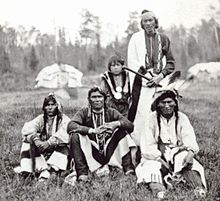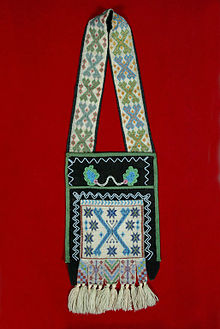Ojibwe
The Anishinabe (Ojibwe ᐊᓂᔑᓈᐯ Anishinaabe) are one of the largest indigenous ethnic groups in North America today. The name is used in two ways today:
- In the broader sense - more correctly in the plural - Anishinaabeg/Anishinabek ("First People", "Original People", or "Being, created out of nothing") - the culturally as well as historically closely related Indian tribes of the Algonkin, Nipissing, Mississauga, Potawatomi, Odawa, Oji-Cree (Severn Ojibwa), Saulteaux (Salteaux) and the Ojibwa (Chippewa) are called Anishinabe. They speak or spoke different varieties and dialects of Anishinaabemowin/Ojibwemowin (ᐊᓂᔑᓈᐯᒧᐎᓐ), an Algonkin language.
- In the narrower sense - Anishinabe or Anishinaabe in the singular - only the tribe known in Canada as Ojibwe or Ojibwa and in the USA as Chippewa, as well as their regional Mississauga and Saulteaux (Salteaux) dialect and tribal groups, are commonly referred to as Anishinabe. They used to refer to themselves as Ojibwe (plural: Ojibweg), but now increasingly as Anishinabe.
This article would like to give an overview of the cultural background and relationship of all tribes of the Anishinaabeg - more detailed information on the individual tribes can be found under the respective articles. If the term Anishinabe is used, it always refers to the Ojibwe (Chippewa) tribe.
The Anishinaabeg originally came from the region around the Great Lakes, but later, due to their expansion west and southwest during the fur trade, their traditional settlement area extended from the Great Lakes across the southern Canadian Prairie Provinces into western Canada as well as the Northern Plains of the United States.
The majority of the Anishinaabeg live today in Canada, the rest mostly in the northeast of the USA, among them the Anishinabe are by far the largest group with about 335,000 tribal members today and are therefore among the largest Indian peoples in North America. The Anishinabe are organized into approximately 125 First Nations in Canada, ranging from western Quebec to eastern British Columbia - among these there are approximately 77,940 Ojibwe (Chippewa); 76,760 Saulteaux (Salteaux) and 8770 Mississaugas - making them the second largest indigenous group among the First Nations after the Cree. According to the 2010 Census, there are also 170,742 Chippewa (Ojibwe) in the U.S., organized into several federally recognized tribes as well as state recognized tribes, making them the fourth largest indigenous group among tribes (surpassed only by the Navajo, Cherokee, and Lakota).
With its various regional dialects, Anishinaabemowin/Ojibwemowin (ᐊᓂᔑᓈᐯᒧᐎᓐ) is the second most spoken indigenous language in Canada (after Cree) as well as the fourth most spoken in North America (after Navajo, Inuit and Cree). Today, approximately 56,531 Anishinaabeg still speak their native language, with Anishinabe again being the largest group with approximately 33,000 native speakers.
Between 1680 and 1800, the Anishinaabeg ethnic group began to expand in order to continue acting as middlemen in the fur trade between the French and British and inland tribes; many groups now established their settlements, often near European trading posts, to supply trading companies with venison, fish, water rice, berries, fruits, and pemmican; to serve as scouts, trappers, and hunters; and to defend the Europeans against hostile tribes (Dakota, Iroquois, Fox, and others). a. o.). Due to the compulsion to adapt to the different tribal areas and due to the close contact in living together with the Europeans (with whom there were often intermarriages, which then gave rise to the Métis), they divided themselves culturally and historically into three groups:
- Fishermen, moose and caribou hunters of the subarctic forests of central and northern Ontario; close to the Cree and today often mixed with them. This group is represented today by the Severn Ojibwa (Ojicree, Oji-Cree) with about 8,000 members (1999).
- Bison hunters of the northern prairies; today Western Ojibwa (Saulteaux, Plains Ojibwa or Bungi) westward from Lake Winnipeg in Saskatchewan to some smaller groups in western British Columbia. They lost their subsistence base with the extirpation of bison in the late 19th century
- Wild rice harvesters, hunters, fishermen, and horticulturists between Lake Nipissing to the east and Lake Winnipeg to the west; now East Ojibwa, Central Ojibwa, and Northwest Ojibwa. The latter include the Saulteaux (Berens River Ojibwa), Lac Seul Ojibwa, Albany River Ojibwa, Lake of the Woods Ojibwa, and Rainy River Ojibwa dialects.
In some publications the northern Anishinabe hunters are called Ojibwa, the prairie hunters Plains-Ojibwa and the southern groups Chippewa.

Among the Anishinabe, wild rice is still one of the most important sources of subsistence and market income.

Distribution of the Anishinaabe(g) tribal groups around 1800 (including the Ojibwa/Chippewa)

Village of the Ojibwa near Sault Sainte Marie 1846, painting by Paul Kane
Tribal name (ethnonym)
The proper name Anishinabe means 'human beings'. The origin of the word 'Ojibwe' is not yet clear. Edmund Danziger (1978) claims that the name derives from Ozhibii'oweg ('Those who keep Records of a Vision'), the name of a neighbouring tribe, while Frances Densmore (1929) puts forward the now generally accepted interpretation, that 'Ojibwe' is a linguistic variant of 'Anishinaabeg' and comes from a verb meaning 'to roast until it curls' (a reference to this tribe's particular way of sealing the seams of moccasins). The omission of the O from O'chippewa (a variant of 'Ojibwe') in erroneous Euro-American documents later led to the emergence of the word Chippewa, which is still used as the official name by the American government.
The Chipewyan tribe, on the other hand, has nothing to do with the Chippewa/Anishinabe, despite the similarity of the name, but belongs to the Athabascan group of peoples.

Historical photo of a group of Chippewa men from the Bad River
History
Together with the Ottawa and the Potawatomi, the Anishinabe formed the Council of Three Fires tribal confederacy before the arrival of the Europeans, which existed in the area of the Great Lakes of North America and the St. Lawrence River and held its own against the Iroquois League.
Euroamerican historiography generally assumes that the Anishinabe migrated from their original habitat to the area west of Lake Huron and east of Lake Superior (now Michigan) in the late 16th and early 17th centuries. There separated from the Anishinabe in the narrower sense the Potawatomi, who settled in the lower peninsula of the state of Michigan, and the Ottawa, who settled on Lake Nipissing in the northern part of the province of Ontario. These two tribes are now regarded as distinct peoples.
According to their own legend, they followed a sacred object, the so-called "Miigis" shell, which had emerged from the ocean. It contained a mission from the spirit world to lead the Anishinabe people to a new land "where food grows in the water" (wild rice). After the Indians arrived at their destination, the shell showed itself to the Anishinabe for the last time and has not been sighted since. The location of this last revelation is usually given as Mooningwanekaning (Madeline Island) in the Anishinaabe Gichigami (Lake Superior).
Under the influence of the fur trade - which soon played a major role in their culture - they spread very widely to all points of the compass. As their main trading partners were the French, they fought on their side against the English in the four North American colonial wars. Some groups moved further westward, driving the Dakota out of what is now the state of Minnesota toward the end of the 18th century.
Beginning in 1840, they had settled in the area north of Lake Superior and Lake Huron and in parts of Minnesota, North Dakota, Wisconsin, Manitoba, and Saskatchewan. From 1850 to 1923, the British entered into a series of land-use treaties with various Anishinabe tribes in Canada. In the United States, the establishment of reservations began in 1854, resulting in increasing assimilation in American society with a move away from traditional economic practices (q.v.: Cultural Change).

Bandolier bag in the permanent collection of the Children's Museum of Indianapolis, probably made for a child, circa 1900.
Questions and Answers
Q: Who are the Ojibwe people?
A: The Ojibwe people are an Anishinaabe people of Canada and the United States.
Q: How big is the Ojibwe people in terms of population?
A: The Ojibwe people are one of the biggest indigenous peoples north of the Rio Grande. They are the second-biggest First Nations group in Canada and the fifth-biggest number of people among Native American peoples in the United States.
Q: Where do the Ojibwe people primarily live?
A: Most of the Ojibwe people live in the United States. They live from western Quebec to eastern British Columbia.
Q: How many Ojibwe people are organized in bands?
A: As of 2010, there are 125 bands of Ojibwe people, including 77,940 mainline Ojibwe, 76,760 Saulteaux, and 8,770 Mississauga.
Q: What groups have a bigger population than the Ojibwe people in the United States?
A: The Navajo, Cherokee, Choctaw, and Sioux have a bigger population than the Ojibwe people in the United States.
Q: What is the population of Ojibwe people in the U.S. according to the 2010 census?
A: According to the 2010 census, there are 170,742 Ojibwe people in the United States.
Q: How wide is the range of Ojibwe people’s habitat?
A: The Ojibwe people live from western Quebec to eastern British Columbia.
Search within the encyclopedia